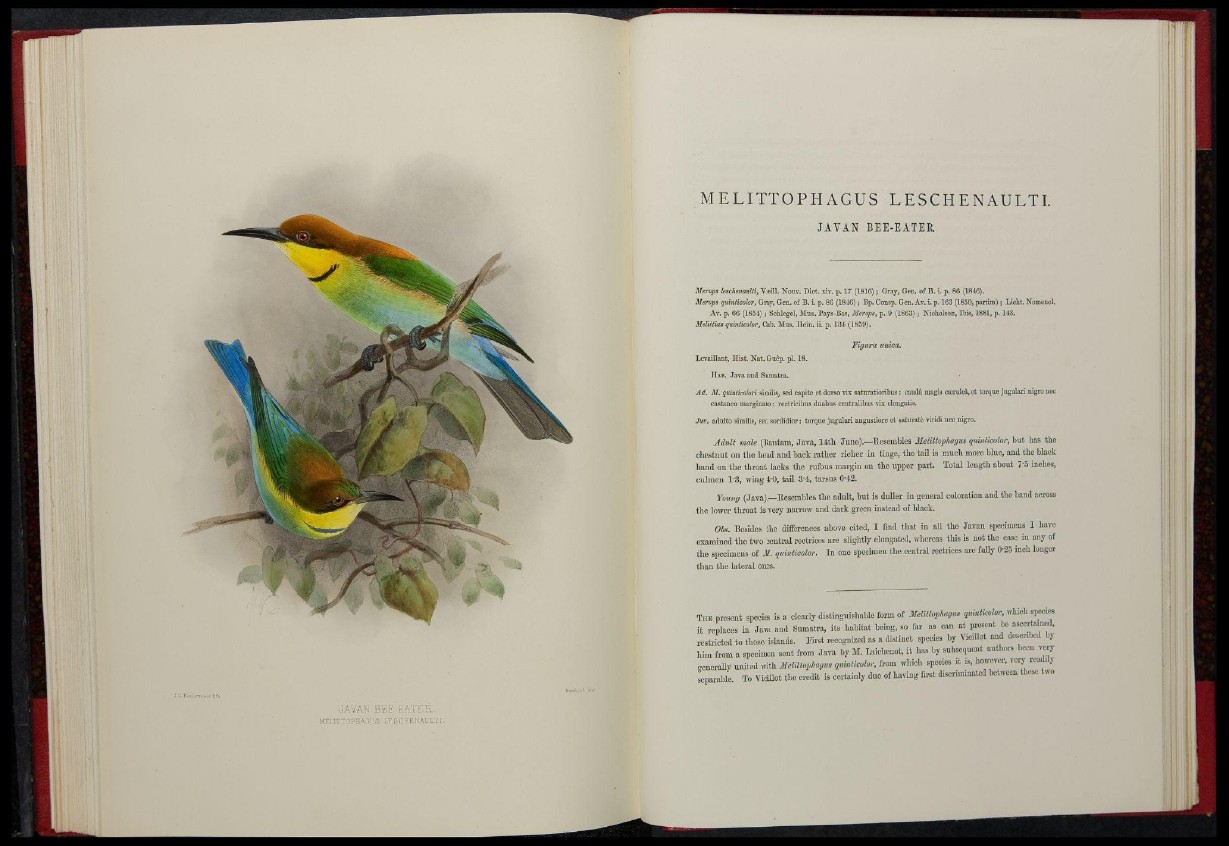
J A V A N B E E E A T ER
MELITTOPHAOUS L E S C H E N A U L T I.
M E L I T T O P H A G U S L E S C H E N A U L T I.
JAVAN BEE-EATER
Merops h-achenaulti, Vicill. Nouv. Diet. xiv. p. 17 (1816); Gray, Gen. of B. i. p. 86 (1846).
Marops qmnlicalor, Gray, Gen. of B. i. p. 86 (1846); Bp. Consp. Gen. AT. i. p. 163 (1850, partira); Liclit. Nomeucl.
Av. p. 66 (1854); Schlcgel, Mm. Pays-Bas, Meropt, p. 9 (1863); Nicholson, Ibis, 1881, p. 143.
Metttliaa qu'mlicolor, Cab. Mns. Hein. ii. p. 134 (1859).
Figura unica.
Lcvaillant, Hist. Nat. Guep. pi. 18.
HAD. Java and Sumatra.
Ad, M, i/uinticolari similis, scd capite ct dorso vis saturation bus : caudii magis cajrulcil, ct torque jugulari nigroucc
castanco margitiato : rcctricibus duabus ccutralibus vix clongatis.
Juv. adulto similis, scd sordidior r torque jugulari angustiore ct saturate viridi nec nigro.
Adult male (Bantam, Java, 14th June).—Resembles MelUtophagus qttinlicolor, hut has tho
chestnut on the head and back rather richer in tinge, tho tail is much more blue, and the black
band on the throat lacks the rufous margin on the upper part. Total length about 7'6 inches,
eulmeu 1*8, wing 1'0, tail 34, tarsus 012.
Young (Java).—Resembles the adult, but is duller in general coloration and the baud across
the lower throat is very narrow and dark green instead of black.
06». Besides the differences above cited, I find that in all the Javan specimens I have
examined the two central reetrices are slightly elongated, whereas this is not the case in any of
the specimens of M. quinticolor. In one specimen the central reetrices arc fully 0-25 inch longer
than the lateral ones.
T m present species is a clearly distinguishable form of Melitto^aou. q»mlkolor, which species
it replaces iu Java and Sumatra, its hahitat being, so far as can at present be ascertained,
restricted to those islands. First recognized as a distinct species by Vicillot and described by
him from a specimen sent from Java by I I . Laichcnot, it has by subsequent authors been very
generally united with XelitlopMim quinticolor, from which species it is, however, very readily
separable To Vieillot the credit is certainly due of having first discriminated between these two